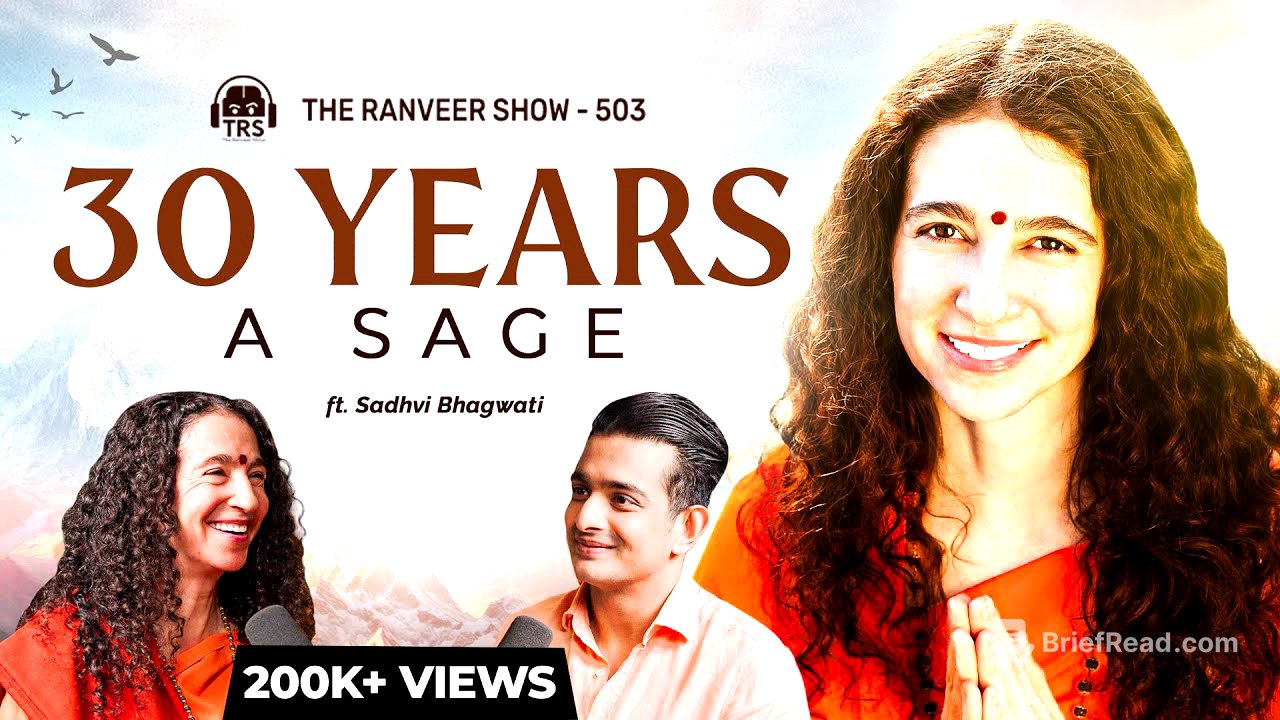TLDR;
Sadi G shares her journey from America to India, highlighting the shift from a materialistic "Hollywood" mindset to a spiritual Himalayan way of thinking. She discusses the pursuit of happiness, the importance of detaching from material rewards, and the significance of controlling one's mind through practices like meditation and mindfulness. Sadi also touches upon the challenges of being a public figure, the need for solitude and spiritual cleansing, and the importance of forgiveness and letting go of past traumas.
- Transition from materialistic to spiritual mindset.
- Importance of inner peace over material success.
- Controlling the mind through meditation and mindfulness.
- Forgiveness and detachment from past traumas.
Introduction [0:00]
Sadi G, an American who has lived in India for nearly 30 years, shares her transformative experience of discovering spirituality in India. Despite not having any Indian heritage, she felt a profound connection to the divine while visiting the Ganga, which led her to stay in India. Sadi reflects on the common dissatisfaction among people in their 30s, despite their achievements, and emphasizes that true happiness cannot be found in material success. She advocates for spiritual practices and meaningful connections as the path to sustained joy.
From Hollywood to Himalayas: The Mindset Shift [2:07]
Sadi talks about her background in Los Angeles and her academic pursuits in pediatric neuropsychology at Stanford. She explains that her initial focus was on understanding the developing minds of children, particularly in the context of neurological limitations. However, her perspective shifted dramatically after coming to India, where she realized that true education goes beyond academic knowledge and involves learning how to be at peace. She contrasts the "Hollywood" mindset, which equates self-worth with physical appearance, wealth, and social status, with the Himalayan way of thinking, which emphasizes the soul, divinity, and oneness with the supreme reality. This shift in mindset, she says, is key to ending suffering.
Attachments and the Pursuit of Happiness [7:06]
Sadi shares her insights on detaching from the past and societal conditioning, noting that many people in their 30s grapple with questions of love, commitment, and happiness. She recounts an experiment where she interviewed high-achievers in various fields and found that none of them were truly happy, as they always conditioned their happiness on future achievements or external factors. Sadi emphasizes that true happiness comes from spiritual practice, service, deep connection, and creativity, rather than material rewards. She also references a friend's perspective on the law of attraction, suggesting that it should be used to manifest peace rather than material goals, as attachment to material things leads to suffering.
The Structure of Indian Society and the Bhagavad Gita [14:23]
Sadi explains how traditional Indian society is structured to prioritize spiritual growth, with the first 25 years of life dedicated to studying the self and the divine. She stresses the importance of understanding that one's identity is not solely based on academic success or material wealth, as this can lead to despair when faced with failure. Sadi uses the examples of Dwarka and Lanka, both cities made of gold, to illustrate that wealth is neither inherently good nor bad; what matters is who is in charge – Krishna or Ravana. She advises young people to work hard and give back to society, but to ensure that their actions are guided by spiritual principles. Sadi recommends the Bhagavad Gita as a core life scripture, especially for the early phases of life, emphasizing the importance of absorbing its teachings rather than just skimming through them.
The Responsibility of Bringing New Souls into the World [20:54]
Sadi expresses a concern about bringing new souls into a world filled with suffering, anger, and pollution. While acknowledging that the decision to have children is personal, she urges people to consider how they can create a world that is safe and nurturing for children. She advocates for shifting the focus from materialistic consumption to the fullness of the self, and for raising conscious, compassionate children who can be leaders of the planet. Sadi also emphasizes the importance of personal integrity and free will, noting that the universe is always watching and that karma ensures that good and bad actions come back to us.
The Challenges of Fame and the Need for Spiritual Cleansing [24:44]
Sadi discusses the challenges faced by public figures like Justin Bieber, who often experience intense scrutiny and have their identities projected upon them by others. She notes that suffering can lead to a deeper understanding of oneself and a cessation of judgment towards others. Sadi points out that even at the height of success, many celebrities struggle with inner depression and addiction because they realize that people love their image rather than their true selves. She emphasizes the importance of having a parallel spiritual path and a community of people who know and accept you on a deep level. Sadi also highlights the practices of meditation and solitude used by musicians like Kendrick Lamar and J. Cole to cope with fame and anxiety, describing these practices as a "spiritual shower" to wash off the projections and expectations of the world.
Mastering the Mind: The Key to Freedom [30:35]
Sadi emphasizes that the goal of life is to control one's own mind, which she describes as the master key to both bondage and freedom. She laments that people often neglect their minds, allowing them to wander into anger, jealousy, and other negative states without control. Sadi advocates for practices like meditation and mindfulness to reclaim control over one's thoughts, and suggests asking oneself two questions when faced with negative thoughts: "Is there an alternative?" and "Is it worth it?" She encourages people to regain their veto power over their thoughts and to choose thoughts that lead to peace and well-being.
Shedding the Past Self: Sadi's Personal Transformation in India [35:58]
Sadi recounts her personal journey of shedding her past self after coming to India. She clarifies that she didn't initially come to India seeking enlightenment, but rather had a profound spiritual experience that transformed her life. While standing on the banks of the Ganga, she experienced a vision of the divine in everything around her, which led her to realize that she was also one with the divine. This realization shattered her long-held belief that she was inherently damaged or flawed due to past traumas. Sadi shares how she heard a voice instructing her to stay in India, which led her to meet her guru and begin her spiritual journey.
Letting Go of Fear and Forgiving the Past [49:29]
Sadi recounts a pivotal moment when she asked her guru how to let go of fear and anxiety. His response was that she feared because she didn't trust, and he challenged her to let go of her past pain and anger. Sadi initially resisted, clinging to the sympathy she received from her story, but eventually realized that she was waiting for someone else to give her permission to heal. She then describes a powerful experience of standing in the Ganga and offering all her pain and anger to the water, finally forgiving her abuser. Sadi emphasizes that letting go of anger and pain involves letting go of the identification with the one to whom the harm happened, and that this is essential for true freedom.
Practical Steps to Spiritual Transformation [57:37]
Sadi outlines five practical steps to spiritual transformation: acknowledging that there is an intelligence in the universe, being open to the plan, being prepared to take the steps, letting go and forgiving, and practicing "neti neti" (not this, not this). She explains that forgiveness is not about condoning the actions of others, but about freeing oneself from the burden of holding onto pain and anger. Sadi describes the practice of "neti neti" as a way to detach from one's physical body, thoughts, emotions, and stories, and to experience the stillness and spaciousness of one's true self. She encourages people to make this a practice in their daily lives, reminding themselves that they are not their bodies or their stories, and to return to this awareness whenever they forget.









